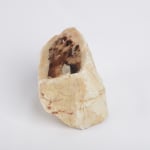ABRE ALAS #18
Anna Menezes, Corpos Sedimentares, 2021
impressão fotográfica sobre rocha
[photo print on rock]
[photo print on rock]
12 x 10 x 12 cm
[4 3/4 x 4 x 4 3/4 in]
[4 3/4 x 4 x 4 3/4 in]
Copyright The Artist
Further images
-
(View a larger image of thumbnail 1
)

-
(View a larger image of thumbnail 2
)

-
(View a larger image of thumbnail 3
)

-
(View a larger image of thumbnail 4
)

-
(View a larger image of thumbnail 5
)

-
(View a larger image of thumbnail 6
)

-
(View a larger image of thumbnail 7
)

-
(View a larger image of thumbnail 8
)

-
(View a larger image of thumbnail 9
)

-
(View a larger image of thumbnail 10
)

As rochas sedimentares são formadas pela junção de detritos, chamados de sedimentos, oriundos da fragmentação de outras rochas, que ocorre na ação dos agentes externos fazendo a transformação do relevo...
As rochas sedimentares são formadas pela junção de detritos, chamados de sedimentos, oriundos da fragmentação de outras rochas, que ocorre na ação dos agentes externos fazendo a transformação do relevo em um processo denominado por intemperismo. Nessa lógica, a obra Corpos Sedimentares retrata, através de fotografias fragmentadas impressas em rochas, diferentes tipos de corpos rompendo com a visão dicotômica entre materialidade-espiritualidade, sensibilidade-consciência, sentir-pensar, natureza-cultura, corpo-espírito. Considera-se que corpos representam identidades, relações históricas em diálogo consigo, com outros, com o mundo, no mundo. Portanto, nessa obra, o corpo funciona como símbolo social, com bagagem histórica e, quando reconhecido pelo indivíduo e os seus, um símbolo ancestral. A escolha do nome Corpos Sedimentares faz conexão com o processo de formação das rochas sedimentares porque os nossos corpos no mundo têm experiências constantes com outros corpos em suas relações sociais. Essas experiências são a junção de desgastes, quebras, sedimentos e detritos que formam esse corpo, que pode ser comparado com a formação da rocha que se quebra e desgasta tornando-se diferentes sedimentos a partir dessas relações naturais. Os espaços da rocha se fundem com os traços do corpo. Há um diálogo entre o corpo da rocha e o corpo humano. Corpo-rocha tornam-se um só, mantendo suas particularidades, mas tendo por eixo aquilo que é a própria vida.
Sedimentary rocks are formed by the layering of debris, called sediments, that are products of the fragmentation of other rocks, which occurs in the action of external agents, transforming the relief in a process called weathering. In this sense, the work Corpos Sedimentares (Sedimentary Bodies) portrays, through fragmented photographs printed on rocks, different types of bodies breaking with the dichotomous vision between materiality-spirituality, sensitivity-consciousness, feeling-thinking, nature-culture, body-spirit. Bodies are considered to represent identities, historical relationships in dialogue with themselves, with others, with the world, in the world. Therefore, in this work, the body functions as a social symbol, with historical baggage and, when recognized by the individual and his family, an ancestral symbol. The choice of the name Corpos Sedimentares makes a connection with the formation process of sedimentary rocks because our bodies in the world have constant experiences with other bodies in their social relationships. These experiences are the junction of wear, breaks, sediments and debris that form this body, which can be compared with the formation of rock that breaks and wears out, becoming different sediments from these natural relationships. The spaces of the rock merge with the lines of the body. There is a dialogue between the body of the rock and the human body. Body-rock become one, maintaining their particularities, but having life itself as an axis.
Sedimentary rocks are formed by the layering of debris, called sediments, that are products of the fragmentation of other rocks, which occurs in the action of external agents, transforming the relief in a process called weathering. In this sense, the work Corpos Sedimentares (Sedimentary Bodies) portrays, through fragmented photographs printed on rocks, different types of bodies breaking with the dichotomous vision between materiality-spirituality, sensitivity-consciousness, feeling-thinking, nature-culture, body-spirit. Bodies are considered to represent identities, historical relationships in dialogue with themselves, with others, with the world, in the world. Therefore, in this work, the body functions as a social symbol, with historical baggage and, when recognized by the individual and his family, an ancestral symbol. The choice of the name Corpos Sedimentares makes a connection with the formation process of sedimentary rocks because our bodies in the world have constant experiences with other bodies in their social relationships. These experiences are the junction of wear, breaks, sediments and debris that form this body, which can be compared with the formation of rock that breaks and wears out, becoming different sediments from these natural relationships. The spaces of the rock merge with the lines of the body. There is a dialogue between the body of the rock and the human body. Body-rock become one, maintaining their particularities, but having life itself as an axis.









